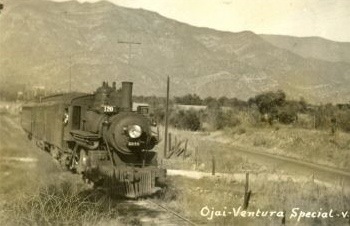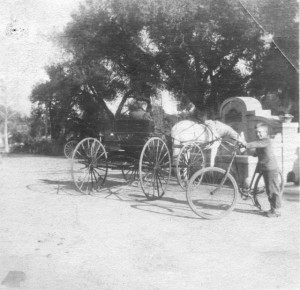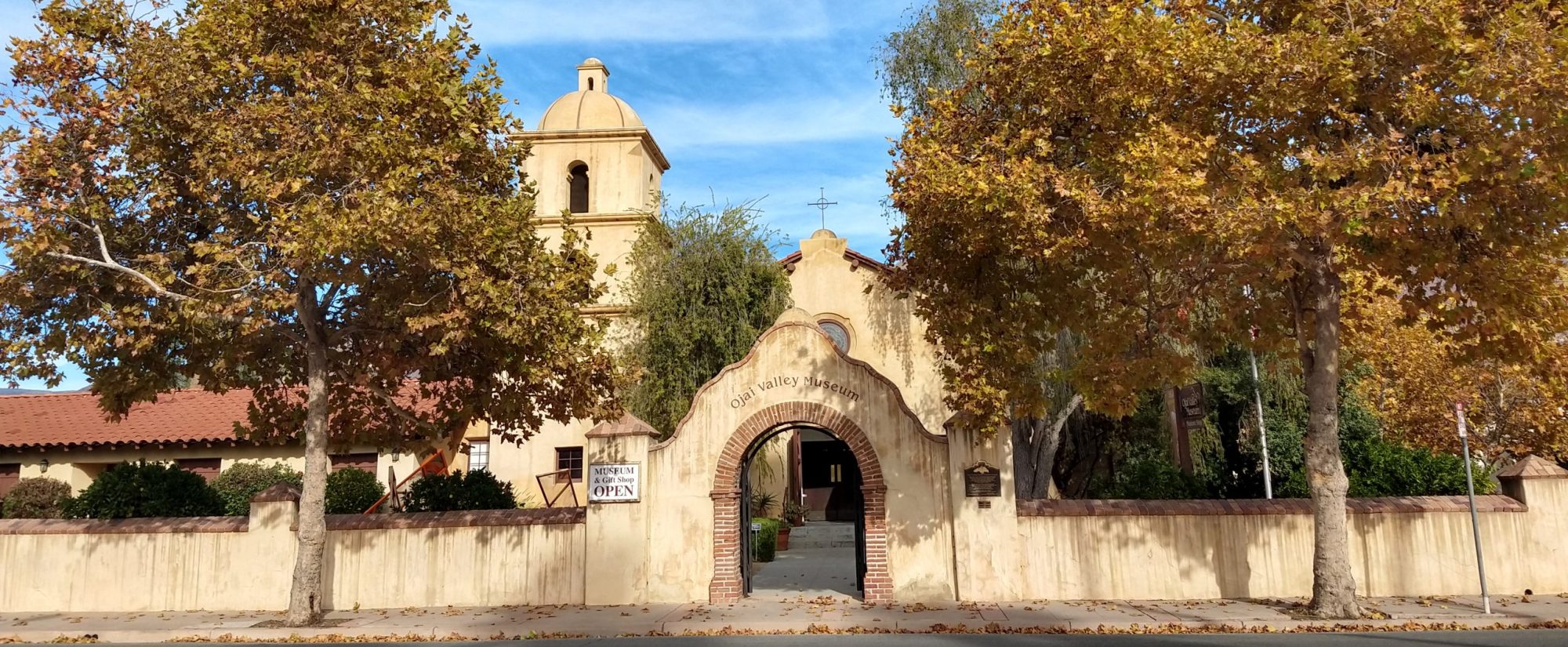Early Ojai Stories, Part VI (More on Ojai Train) by Howard Bald
Howard Bald describes life in turn-of-the-century Ojai in these articles from 1972.

There were other incidents in connection with the “Ojai Flier” or”The Cannon Ball” that might be worth mentioning. One of the train crew lived with his family on Signal Street, the old two-story house now occupied by a masseur [Inn Harmony]. His daughters in the evening would hitch the old white mare to the buggy and park them near the side door. When they heard the train whistle in the distance, one or all three daughters would jump in the buggy and dash off to meet their daddy.
One evening a daughter went out, and finding no horse and buggy waiting, decided that one of the other sisters had gone alone and thought nothing of it. When father checked out from his “run”, he found the horse and buggy in the customary place. After looking around and finding no daughters, he drove home alone. Later it was revealed that the old white mare was seen jogging down Signal, up Main Street to Fox, and down to the depot on her own.
A few years later my young sister decided to make Peggy, our two year old colt, acquainted with the train. Margaret was riding bareback with only a hackamore. Peggy took a pretty dim view of the hissing monster, putting on quite a scene, and at one time was in the middle of someone’s buggy. But through it all, Margaret stayed astride her.

One time I was sent from the livery stable with a horse and buggy to meet a domestic of the Edward Thachers on Topa Topa Ranch coming in on the train. It was winter and, of course, dark when the train came in. We soon had the old gal and her belongings loaded and were off up Ojai Avenue. By the time we turned off onto Reeves Road (it wasn’t much more than a narrow, winding, rocky trail then and I don’t believe it had a name) the poor old Scandinavian was having some misgivings as to the reliability of her escort. She couldn’t understand why I didn’t drive faster.
I did my best to reassure her, pointing out that the road was rocky and narrow. When we turned up McAndrew road and the horse travelled even slower, she was really convinced that I was lost. There was nothing, though, that she could do, for it was pitch dark and I don’t suppose she even ha a pair of reins in her hands. It probably wasn’t eight o’clock when we drove into Topa Topa yard, and Mr. and Mrs. Thacher appeared with coal oil lanterns. But that lady, I guess, considered it a harrowing experience.
It was wintertime when once my mother, my sister and I were going someplace by train. As we groped our way on foot from Signal to Fox Street in the dim dawn, we heard the locomotive give some sharp whistles, but we sauntered along until we discovered the train was at the Fox Street crossing. Mr. Spence, the engineer, knew we were no aboard and was waiting there for us.
Another time most of Nordhoff went to Santa Barbara to a circus. We arrived via train in Ventura at 7 a.m. and had quite a wait there for another train, but were in Santa Barbara in time for the parade, saw the afternoon performance, then took a southbound train back to Ventura, arriving in time to catch the Ojai Flier home. I am not sure but what it had to wait for us in Ventura.
Mr. Spence, the engineer, was a kindly old gentleman, and once he took me with him on the locomotive, a cod burner, to Los Angeles and back, a two-day trip with 24 hours of travel. It was one of the events of my young life (I was probably 10 then), but alas it was somewhat marred by my introduction to indoor plumbing. I had never seen or heard of anything of the kind, and the whole thing was too embarrassing for words. No one knew how I suffered. Mr. Spence doubtless thought me a very unresponsive and unappreciative youngster. It was my first experience with electric lights, too. In the center of each room a cord hung from the fixture in the ceiling.
Well, so much for railroading. We will next dwell on the village of Nordhoff.

Great story! When my family first moved to Ojai in 1956, we lived in the two-story house Howard Bald describes at the beginning of this article. I was about 8 or 9 when we lived there, so I would often run down to put pennies on the train tracks. My father won a prize for remodeling that old home–he added a modern wing off one side and gave the interior a very contemporary look. Since then it’s been expanded and taken back to its Victorian roots.
I certainly cannot take you back as far as Howard Ball concerning the Ojai Train, but I’ve got a short story to tell you about it that you might find amusing. In 1963, our family moved into the home my parents had built on South Rice Road in Mira Monte and only a short distance from Mirror Lake. This was during the summer when I was 12 years old. I had to have something to keep me busy, so I decided I was going to build a wooden raft to float on Mirror Lake. A couple of buddies joined me in the construction of that raft because they convince me we used their grandfather’s extra split-rail fencing as the main lumber. This natural pothole occupied the area south of Woodland Avenue and bordered on the east by the railroad which is now the “Ojai Valley Trail”. If I recall correctly, I don’t believe that the stretch of Woodland Avenue that runs from Highway 33 to Rice Road even existed. We’d hoof it over open fields, now covered with homes and a mobile-home park, from Rice Road to get to the lake. The lake was only about 6 – 8 feet deep at it’s deepest point. We’d get on the raft and use long poles to push off the bottom of the lake to move us around. Often times, when we were out rafting on the lake, the train would be chugging past. There wasn’t much to the train. Seems like it usually only had an engine and one or two cars, and only two gents operating it. Sometimes, these two gents would stop next to Mirror Lake when they saw us out on our raft. Usually, it was in the middle of the day and around lunch time. The two gents would stand on one of their cars and talk to us while they peeled back the waxed-paper that wrapped their sandwiches. They never worried that they’d be in the way of another train because……………there wasn’t one! This is a great childhood memory of mine.
I remember the train whistle in Ojai and also the Mira Monte area where we lived. Sure miss those sounds.
Most of all of my vacations involve riding the old railroads . Love those old trains.
I don’t know how I got this but the print that is on the 2009-2010 Ojai phone book I have the metal stamp for that . Its framed and on the wall in my dining room.
We also used to put pennies on the tracks so the train would flatten them. We also used to put form board nails (two headed) the would flatten out and look like a small sword.
I miss the far off horn of the Ojai train, fond memories,
Nice stories! I unfortunately wasn’t even around when the line was still running to Canet, but biked some of its remnants from Bryant Street to Oak View.
I’m working on building a simulator version of the line with present-day scenery upon the old right-of-way. However, I don’t know what the yard in Ojai looked like.
Would anyone be able to post a schematic of trackwork for the yard?
Hi, Alex,
Perhaps you could stop in at the Ojai Valley Museum one day and talk with David Mason. He can refer you to a tree that marks the spot of the station. There’s also a book at the museum that has some pictures of the old line.
The old Ventura and Ojai Valley Railway, eventually, became the “Ojai Valley Trail” and the “Ventura River Trail”. I suggest you obtain a copy of the Ojai Quarterly magazine (Summer 2013), then go to page 128 for a really informative article and photos by Holly Roberts. The article is titled, “FROM RAILS TO TRAILS/How the Ojai Bike & Horse Trail was won”. This magazine is free and can be found on small stands throughout the Ojai Valley.
Fantastic article, Holly! Thank you!!!
Thankfully my sons were able to play in the river bottom with their be be guns, of all things – (GASP!) Sadly it is now OFF LIMITS for youngsters in that manner!
We lived in Oak View. When I was in my teens in the early 40’s, on hot sultry nights, I would sit at the window in my bedroom and would hear the awesome sounds of the train as it was on it’s way back to Ventura. Or maybe it was on it’s way back to Ojai? Pleasant memories.
I lived on the corner of Loma drive growing up and I remember running out to the edge of the driveway to wave at the people on the train when I was about 6. It was the highlight of the day!